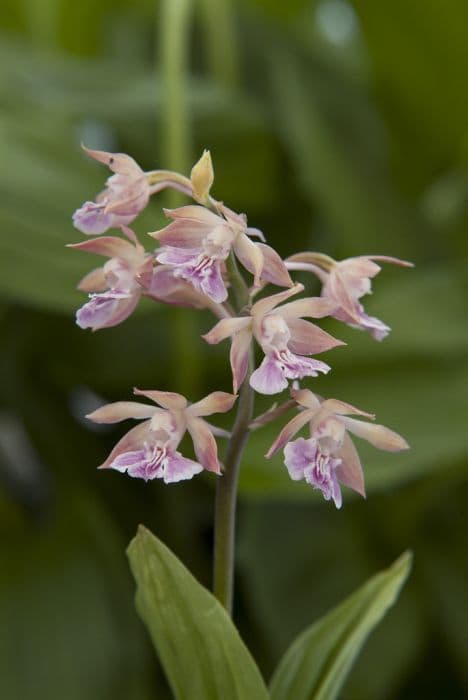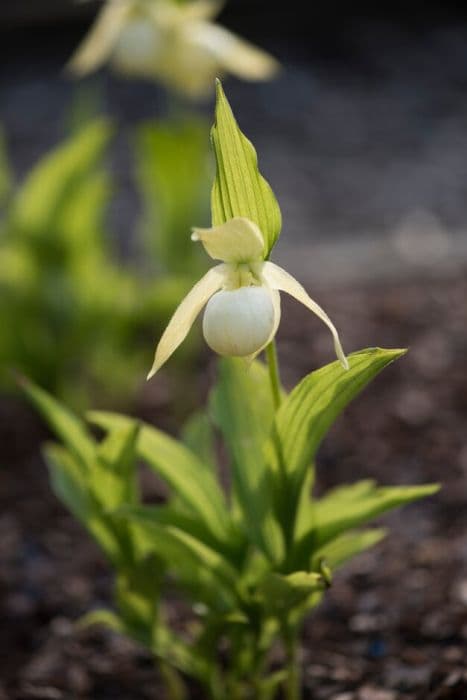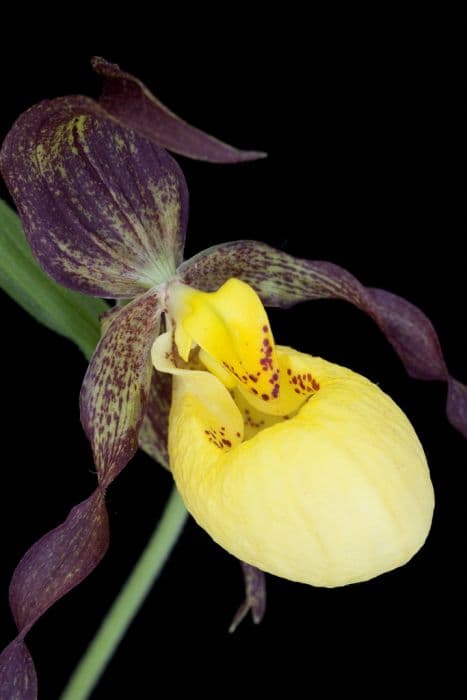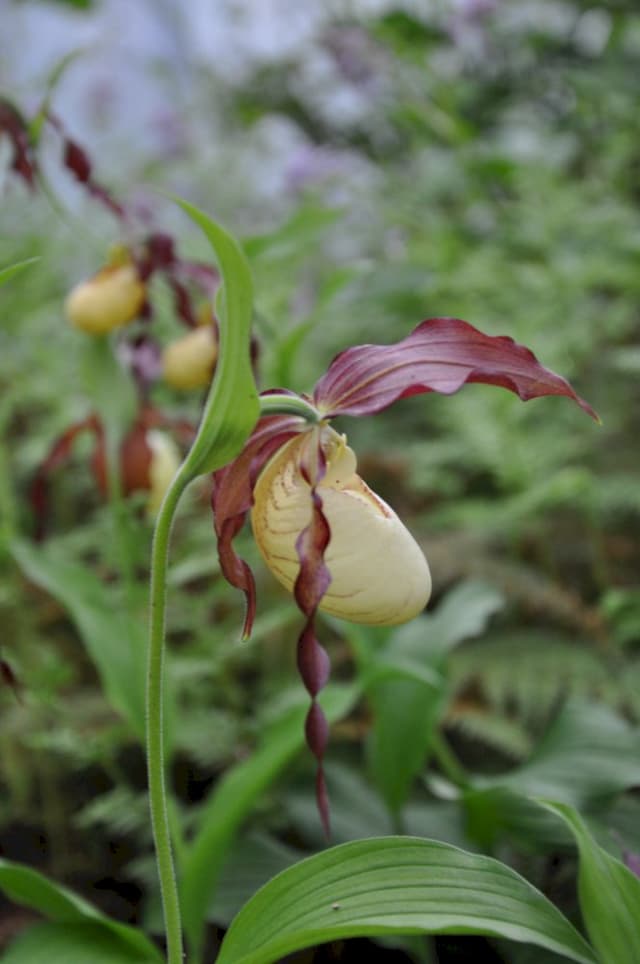Bee Orchid Ophrys apifera

ABOUT
The plant known as the bee orchid is distinctive and charming, notable for its flowers that remarkably mimic the appearance of bees. This unique characteristic is a form of mimicry that the plant employs to attract pollinators, despite being largely self-pollinating. The flowers display an intricate pattern of brown, white, and yellow colors, set against a backdrop of green foliage. The central part of the flower, designed to imitate the body of a bee, possesses a velvety texture and is mainly brown, with a pattern that resembles the furry thorax of a bee. Around this brown patch, there are yellow-tinged areas with a sheen that mirrors the shine of a bee’s wings. This beautiful facade is complete with white areas that have pink to purple accents, evoking the appearance of the reflective light on insect wings. Each of the bee orchid's blossoms is supported by a spike that harbors several buds, which unfold in succession. Its leaves are basal, meaning they grow at the base of the plant. They are typically lance-shaped and present a lush green color that contrasts with the dramatic hue of the blooms. The leaves may also have spots or streaks, contributing to the overall variegated appearance of the vegetation. Overall, the bee orchid captivates the observer with its floral mimicry, demonstrating a fascinating and complex example of evolution within the plant kingdom. Its likeness to bees not only aids in its survival through pollination tactics but also ensures that it is a source of wonder and study for botanists and nature enthusiasts alike.
About this plant
 Names
NamesSynonyms
Bee Orchid, Bee-Flower.
Common names
Arachnites apifera, Ophrys insectifera var. apifera, Ophrys aranifera var. apifera.
 Toxicity
ToxicityTo humans
The plant commonly known as Bee Orchid, Ophrys apifera, is not generally considered toxic to humans. There are no well-documented cases of poisoning from ingestion of this plant, and it is typically not listed among poisonous plants. However, as with many wild plants, it is advisable not to ingest any part of plants that are not known to be safe to eat.
To pets
Bee Orchid, Ophrys apifera, is also not generally recognized as toxic to pets. There is limited information on the effects of this specific orchid on household pets, but it is not commonly reported to cause poisoning in animals. As with humans, it is usually best to prevent pets from ingesting plants that are not confirmed to be safe for consumption.
 Characteristics
CharacteristicsLife cycle
Perennials
Foliage type
Deciduous
Color of leaves
Green
Flower color
Mixed
Height
1-2 feet (30-60 cm)
Spread
6-12 inches (15-30 cm)
Plant type
Herb
Hardiness zones
5
Native area
Mediterranean
Benefits
 General Benefits
General Benefits- Ecological importance: Bee Orchid (Ophrys apifera) provides nectar and pollen to pollinators, thus contributing to the biodiversity and health of ecosystems.
- Habitat creation: This plant creates microhabitats that are crucial for the survival of certain insects, especially its pollinators which are primarily bees.
- Aesthetic value: With its unique bee-like appearance, the Bee Orchid adds beauty and interest to natural landscapes and cultivated gardens.
- Educational interest: Due to its intriguing pollination strategy mimicking bees, it is a fascinating subject for educational studies in botany and ecology.
- Conservation indicator: The Bee Orchid can indicate the health of a habitat, as it thrives in undisturbed environments, making it a useful species for conservation monitoring.
 Medical Properties
Medical PropertiesThis plant is not used for medical purposes.
 Air-purifying Qualities
Air-purifying QualitiesThis plant is not specifically known for air purifying qualities.
 Other Uses
Other Uses- The Bee Orchid's unique flower structure has been used as a tool for education and research in evolutionary biology, demonstrating how natural selection can produce complex flower forms to attract specific pollinators.
- With its distinctive bee-like appearance, the Bee Orchid is often used in photography and botanical illustration workshops to teach techniques for capturing the intricate detail of flowers.
- Due to its rarity and intriguing aesthetics, the Bee Orchid sometimes forms part of specialized horticultural collections and botanical gardens dedicated to the conservation of orchid species.
- The flower serves as an inspiration for artists and designers, who may use its unique shape and form as a motif in jewelry, textiles, and other design work.
- In some regions, the Bee Orchid is used in local folklore and storytelling to teach lessons about nature, mimicry, and the importance of biodiversity.
- The Bee Orchid may be used as a symbol or emblem for environmental campaigns and conservation efforts emphasizing the protection of wildflower habitats.
- Specialists in the perfume industry sometimes study the scent of the Bee Orchid as part of their research into creating new and unique fragrances.
- The plant has occasionally been used in wedding decorations and floral arrangements for its unique appearance, although its rarity can make it difficult to source.
- Plant enthusiasts sometimes use the Bee Orchid as a plant for competitions in orchid shows, highlighting its unique characteristics and rarity.
- The Bee Orchid's life cycle and growth requirements can be used in educational curriculums focusing on plant biology, ecology, and the challenges native plants face due to habitat loss and climate change.
Interesting Facts
 Feng Shui
Feng ShuiThe Bee Orchid is not used in Feng Shui practice.
 Zodiac Sign Compitability
Zodiac Sign CompitabilityThe Bee Orchid is not used in astrology practice.
 Plant Symbolism
Plant Symbolism- Deception: Ophrys apifera, commonly known as the Bee Orchid, exhibits a remarkable form of mimicry; its flowers resemble a female bee to attract pollinating male bees. This symbolizes deception or trickery in the plant world as it deceives insects to aid in pollination.
- Rarity: The Bee Orchid is known for its rarity in certain regions, symbolizing uniqueness and the preciousness of scarce entities.
- Beauty in Solitude: As a plant that often grows solitary, the Bee Orchid symbolizes the beauty that can be found in solitude and the strength to stand alone.
- Adaptability: The ability of Bee Orchids to self-pollinate in the absence of their bee pollinators is symbolic of adaptability and self-sufficiency.
- Attraction and Seduction: Given its mimicry of the female bee to attract male bees, the Bee Orchid can symbolize the themes of attraction and seduction.
 Water
WaterThe Bee Orchid, commonly known as Ophrys apifera, requires minimal watering compared to other plants. Water the Bee Orchid sparingly, allowing the soil around it to dry out completely before watering again. Typically, during the growing season, watering once every 10 to 14 days with about 8-12 onzes of water should suffice, depending on the environmental conditions. During dormant periods, which occur after the flowering season, reduce watering to once a month or less. Over-watering can lead to root rot, so it's important to ensure good drainage and avoid letting the plant sit in water.
 Light
LightBee Orchids flourish in bright, indirect light but can tolerate partial shade. They should not be exposed to direct midday sunlight, which can scorch their leaves. Placing them near an east or west-facing window where they can receive morning or late afternoon sun is ideal for their growth and flowering.
 Temperature
TemperatureThe Bee Orchid, Ophrys apifera, does best in temperate climates with temperatures ranging between 50-77 degrees Fahrenheit. They can survive short periods at minimum temperatures of 32 degrees Fahrenheit but prefer not to be exposed to freezing conditions. The ideal temperature range encourages healthy growth and successful flowering.
 Pruning
PruningPruning Bee Orchids, or Ophrys apifera, is typically limited to removing faded flowers and dead foliage. This cleanup helps the plant focus its energy on new growth. Pruning can be done immediately after the flowers have faded. The Bee Orchid does not frequently need pruning, and it's best to do so once a year after the flowering period.
 Cleaning
CleaningNot needed
 Soil
SoilThe Bee Orchid prefers a well-draining soil mix with a pH of 7.5-8, which is slightly alkaline. A mix of loamy or sandy soil amended with chalk or limestone can work well for this plant. Ensure good aeration and avoid waterlogged conditions to prevent root rot.
 Repotting
RepottingBee Orchids do not need frequent repotting as they prefer to be left undisturbed. Repotting is typically only necessary every 2-3 years, unless the soil medium breaks down and compromises drainage.
 Humidity & Misting
Humidity & MistingBee Orchids thrive in moderate humidity levels, around 40-50%. They can tolerate some variation, but it's important to maintain consistent humidity without letting the air become too damp.
 Suitable locations
Suitable locationsIndoor
Provide bright, indirect light and ensure good air flow.
Outdoor
Plant in partial shade with well-draining soil.
Hardiness zone
6-9 USDA
 Life cycle
Life cycleThe Bee Orchid (Ophrys apifera) begins its life as a seed that relies on a symbiotic relationship with mycorrhizal fungi for germination and initial growth. The plant then develops a tuberous root system and a rosette of basal leaves during the vegetative stage, gathering energy for the next phase of its life cycle. After a period of dormancy, typically over winter, the Bee Orchid sends up a flowering spike in late spring to early summer. The flowers, which mimic the appearance of bees to attract pollinators, self-pollinate as pollinators are often absent in its non-native range. Following pollination, the plant produces seed capsules filled with numerous minute seeds. The adult plant may die after seeding, but the newly produced seeds carry on the cycle, dispersing to start new colonies of Bee Orchids.
 Propogation
PropogationPropogation time
Spring to Summer
The Bee Orchid, or Ophrys apifera, is commonly propagated through seed dispersion, which aligns with its natural reproductive process. This method entails the seeds being spread by the wind or by the aid of pollinators, although in Bee Orchids, actual insect pollination is rare as they are capable of self-pollination. The Bee Orchid has dust-like seeds that do not contain an endosperm to provide nourishment for germination and growth. Therefore, in cultivation, the most popular method of propagation is symbiotic germination, where the seeds are sown in the presence of mycorrhizal fungi. The fungi form a symbiotic relationship with the orchid seeds, providing necessary nutrients to initiate germination and to sustain the initial growth of the seedlings. This approach of propagation requires careful control of environmental conditions, such as temperature, humidity, and sterility, to support both the growth of the fungi and the developing orchid seedlings. It is a delicate process that mimics the natural dependencies these orchids have in the wild.









